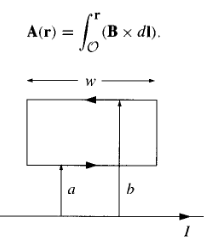Another way to fill in the missing link in Fig. 5.48 is to look for a magnetostatic
Question:
(a) Test this formula for the simplest possible case--uniform B (use the origin as your reference point). Is the result consistent with Prob. 5.247 You could cure this problem by throwing in a factor of ½, but the flaw in this equation runs deeper.
(b) Show that f(B x d1) is not independent of path, by calculating f(B x dl) around the rectangular loop shown in Fig. 5.63.
As far as I know 19 the best one can do along these lines is the pair of equations
(i) V(r) = €“ r ˆ™ f01 E(λr) dλ,
(ii) A(r) = €“ r x f01 λB (λr) dλ.
[Equation (i) amounts to selecting a radial path for the integral in Eq. 2.21; equation (ii) constitutes a more "symmetrical" solution to Prob. 5.30.]
(c) Use (ii) to find the vector potential for uniform B.
(d) Use (ii) to find the vector potential of an infinite straight wire carrying a steady current 1. Does (ii) automatically satisfy ˆ† ˆ™ A = 0?

Step by Step Answer:






